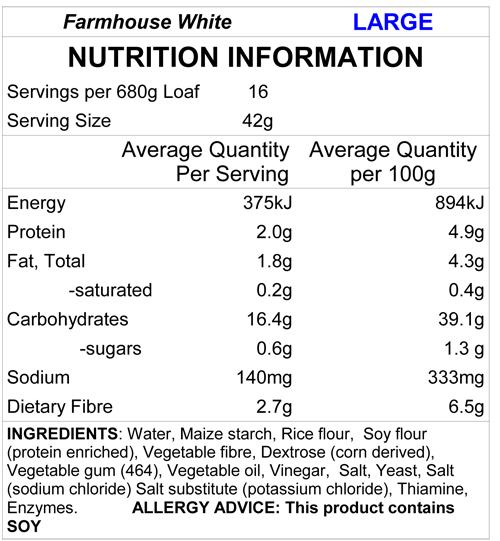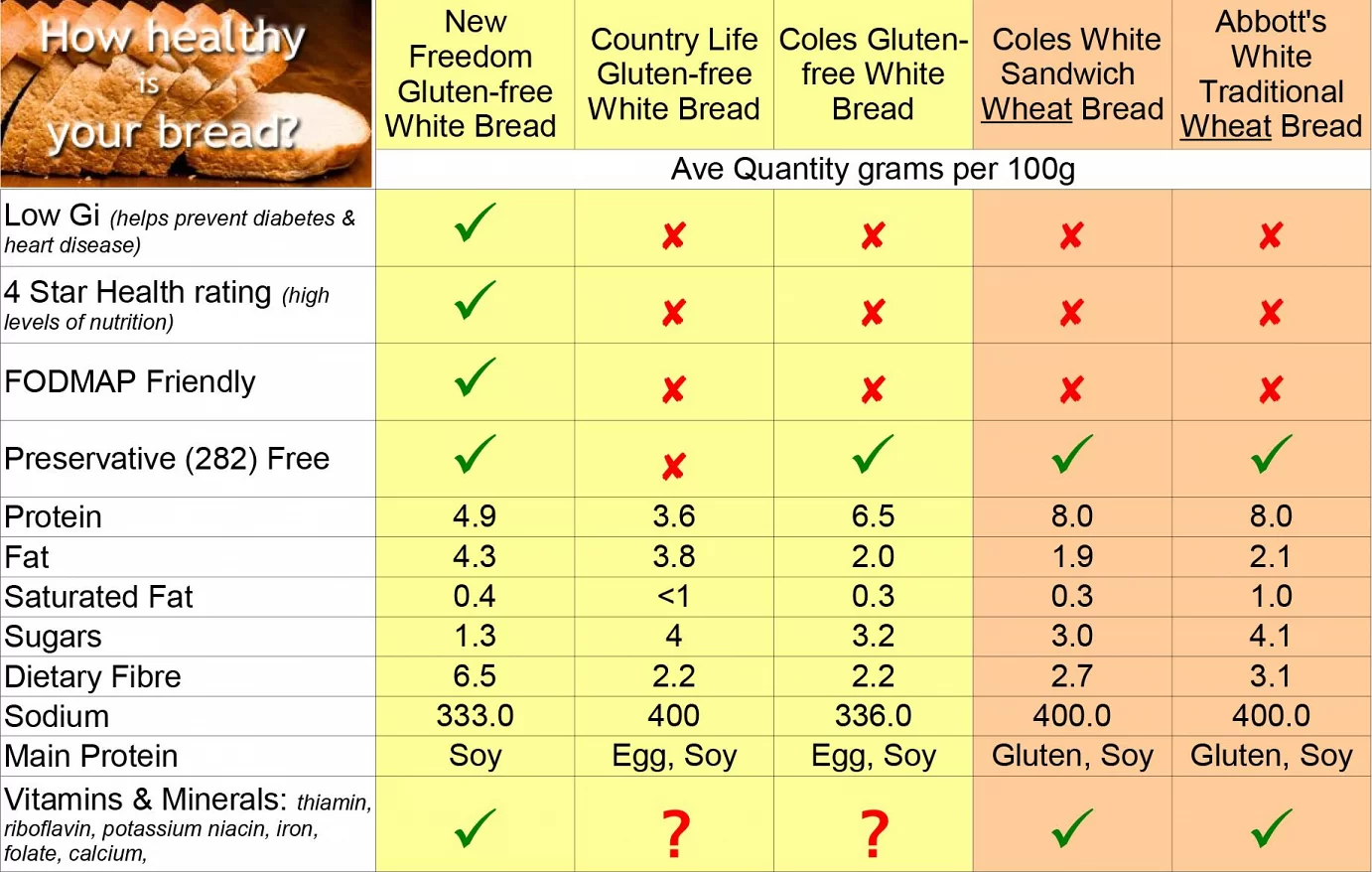Nutritional Information
What ingredients are in the breads made from Tru-Dough Bread Mix?
We have many products in our bakery.
This nutrition panel is for our most popular - the New Freedom Bakery Farmhouse White Loaf.

This formulation provides you with a lowGi, low, FODMAP, 4 Star Health rated bread.
Over time we will add nutrition panels for our other products.
Meanwhile, if you require further specific information on a product, while we can't send a list via email, customers are welcome to get further information in the bakery.
Can I make such Great Bread at Home, or in a Bread-Machine?
Yes you can make breads by hand in your home oven, and in some bread machines. The Home Baking section all the information you need to make excellent breads at home using minimal equipment.
Are our breads Healthy?
Yes they are.
It is well publicized that many gluten-free breads are made from over processed “empty starches” that do not provide the nutrition (adequate levels of protein, slow energy release carbohydrates, low sugar, healthy fats, good fibre levels, lower sodium, vitamins & minerals) compared to wheat breads. Breads from our bakery made with our Tru-Dough mix provide many health benefits. Compare the following for both gluten-free and wheat breads...

LOW Gi:
Recent university test have declared our breads to be LOW Gi. They achieved a score of 50. (below 55 is LOW Gi). Very few breads achieve this excellent score. Low Gi foods have been shown to help with weight loss, help prevent diabetes, and other chronic lifestyle diseases. They provide a slow release of energy into the blood stream rather than cause a blood sugar "spike".
HEALTH STAR RATING:
The Health Star Rating for foods is rapidly becoming the preferred way for consumers to see at a glance whether a food is healthy for you. It will soon be compulsory for all foods to carry a Health Star Rating. The more stars - the healthier. Our breads have achieved a 4/5 star rating... which is very good for bread. Stars are awarded for the overall balance of their nutritional qualities and include carbohydrates, protein levels, salt, fat, sugar, and fibre levels.
Other Potential Health Benefits of Gluten-free Tru-Dough Mixes
Several indicators point to the Tru-Dough mix - and therefore products made from it - as having other health benefits to consumers.
Our bakery products provide a regular source of energy from gluten-free and wheat free carbohydrates which provide relief for our growing customer base world wide who suffer from coeliac disease and a wide range of other debilitating symptoms and conditions now directly associated with the consumption of gluten and or wheat. We have also chosen to design the mix with regard to other well known allergens with a view to making the product as allergy free as possible whilst retaining maximum functionality, flavour and textural characteristics we have become known for.
ALLERGY FRIENDLY
Our Tru-Dough Mix can produce breads which are
GLUTEN-FREE,
WHEAT FREE,
DAIRY-FREE,
NUT-FREE,
EGG-FREE,
These are considered among the top major allergens affecting significant numbers of the population.
FODMAP FRIENDLY
FODMAP intolerance is a growing issue for many in our communities. As cane sugar is part fructose and part dextrose, many wish to avoid foods with can sugar. There is no cane sugar in the Tru-Dough Cottage Mix and apart from our sweet fruit loaves and fruit buns, we do not use can sugar in our breads.
As we have chosen to use dextrose rather than cane sugar as early acting yeast food during the fermentation stage of baking, our mix is suitable for those with fructose malabsorption.
Tru-Dough bread mix is naturally low in salicylates.
While salicylates are natural types of acids found in most fruits and vegetable, those with sensitivities to these can suffer from a range of symptoms and conditions.
We have no ingredients which are high in salicylates in the Tru-Dough Mix and the white vinegar (recommended in the recipe for bread-making but not included in the mix itself) may be omitted without serious alteration of the bread key properties.
DIGESTIVE TRACT FRIENDLY
Special Fibre Attributes:
Breads made from the Cottage Mix not only provide a source of fibre in one's daily diet. The special soluable dietary fibre in our breads also provides a smooth transit through the digestive system and can significantly reduce bowel movement difficulties and greatly assist with providing a clean stool bowel exit.
Apart from our customers really appreciating this feature in their own personal lives, this makes our breads also particularly suited to high care institutions.
HEART AND ARTERY FRIENDLY
Our breads are lower in salt than typical wheat breads.
Typical wheat bread salt levels have been slowly decreasing over recent years as pressure from the Government health sector has increased... due to the well known health risks associated with high levels of sodium intake.
Many supermarket breads now “boast” a sodium level of around 400mg per 100gm.
When made to directions, breads from the Tru-Dough mix exhibit sodium levels of around 330mg per 100gm. This lower level is in part achieved by using a careful blend of potassium chloride and sodium chloride.
Low fat and minimal saturated fats
When prepared according to directions, breads made from the Tru-Dough mix have just 1.3gm fat and 0.1gm saturated fat per 100gm.
Low sugar
Carbohydrates from sugars in the final bread products are just 1.3gm per 100gm.
OTHER GOOD NUTRITION CONTENT
Breads made from the Tru-Dough mix contains significant levels of many other essential nutrients including proteins, isoflavones, saponins, phytosterols, lysines, potassium, phosphorus, calcium, magnesium, iron, vitamins B1,2,3,6 and many other trace elements.
How hard is it to make my own bread?
Check out our videos on this site for more information
Why is gluten-free food so expensive?
The cost of each ingredient is much higher than wheat. When you then have to source and blend these ingredients in a totally gluten-free environment with layers of extra vigilance and safety systems, the costs of production of the mix also sky-rockets. When the breads are then made by artisan bakers and not mass produced on industrial sized machinery the labour costs are also much higher.
Do you have any gluten-based products in your bakery?
No.
Can you make breads that leave out certain other ingredients... like soy, maize or rice?
It is possible to alter some ingredients and still produce a reasonable loaf. However, the costs of doing this are substantial as each new customized blend of ingredients has to be scheduled and done separately. This can take months of preparation and will add dramatically to the already high cost of production. There will be a minimum order ( a number of tonnes per order) and time (6 months +) required for this. This can be discussed with the manager.
Why aren't there recipes available for pastries and cakes and slices?
Some of our recipes are very difficult to make and require specialized equipment and skills.
Some of these processes are proprietary and we are not at liberty to explain to others how me make these products.
What do I do if I think I got sick from eating your bakery products?
We take your concerns very seriously and will investigate any concern you may have very thoroughly.
We have a clear process for customers and staff to follow. Always approach a staff member first who will then call a manager. They will show you the procedures that need to be followed to enable a full investigation to resolve the issue and work with you and the bakery senior management if required. Do this as soon as you can after feeling any ill affects as the longer the time between your concerns and when we can investigate, the harder it is to track the possible cause.
Can we get the bread mixes interstate or overseas?
We can send the dry mixes anywhere in Australia via Australia Post. Our carefully chosen ordering dispatch and freight system is designed to get your products delivered quickly and safely and at a very reasonable cost. We are unable to accommodate alternative customer- nominated freight services.
Currently we are unable to send our mix overseas. Freight costs and customs regulations around food products make it difficult at present, however we are seeking ways to make the mix available internationally as soon as practical.
Can I get your fresh baked products sent to me?
The Freshness Issue:
We have available a limited range of bread products which can be delivered within a limited delivery area of Bendigo. Customers may organize their own delivery to other areas.
But, as product freshness is a key part of eating enjoyment, customers need to be aware that deliveries which delay eating beyond the day the products were made, will reduce the eating enjoyment.
NOTE: As we do not have preservatives in our breads, mould may also form within a few days... especially in summer or humid conditions.
Product Safe Arrival Issue:
If you collect the goods yourself, or arrange for someone to pick-up your order from the bakery, make sure you consider the packaging and transport requirements to get it to you in safe and appealing condition. The bakery has very limited packaging options and may or may not have suitable cartons at any time to pack your goods in to prevent squashing during travel. Fresh breads and patisserie squash easily!
If you order products requiring cold transport, make sure you provide suitable refrigeration for the trip. Remember the basic rules to prevent spoilage....
High risk products like cream, eggs, and meat need to be kept below 5DegC during transporting or they will spoil within 4 hours and may become dangerous to consume.
Storage & Freezing:
The ability to store fresh bread and keep it fresh, varies with the ambient temperature that it is stored at.
It is therefore affected by your house temperature and weather and climate. A basic rule is... the warmer the temperature surrounding the bread, the 'fresher' it will remain but the quicker it will attract mould growth. Stored at 25 - 35degC will keep it fresh for 2-3 days. After this, reform in the microwave back to very warm/hot (approx. 30 seconds per slice), allow to cool on a wire rack before enjoying.
Microscopic moulds and yeasts are everywhere in the air and on kitchen surfaces and will readily colonize your fresh warm bread as air gets to it. So depending on your environment mould may become a problem from day 3 onwards as we do not use mould inhibitors in the breads.
Storage in cool temperatures (like refrigerators) slows mould growth but also dries and stales bread quicker.
To use fresh for 2-3 days:
after the bread has completely cooled from baking,
- place bread in an airtight bag
- gently suck most of the air out
- seal with a tie
- leave in a warmish area (25-35degC) and consume within 3 days
or
To freeze and thaw as required:
After the bread has completely cooled from baking,
- place bread in an airtight plastic bag
- gently suck most of the air out
- seal with a tie
- freeze for up to 3 months
- remove slices as required (slices should easily dislodge from each other) If your loaves have not been compacted in transit
- refresh in the microwave for approx. 30 seconds on high per slice - bringing the slice back to very warm/hot and cool on wire rack for a few minutes before making sandwiches or enjoying as required
You can make sandwiches in the morning, wrap in plastic lunch-wrap and they will stay fresh for lunch. Do not use direct from freezer as the cold starches in the breads will feel too dry to eat at lunch-time.
Toasting from Frozen:
Allow to mostly thaw (using toaster thaw feature or microwave for 10-15 seconds) and toast as required. GF breads take a little longer than wheat breads to toast.
